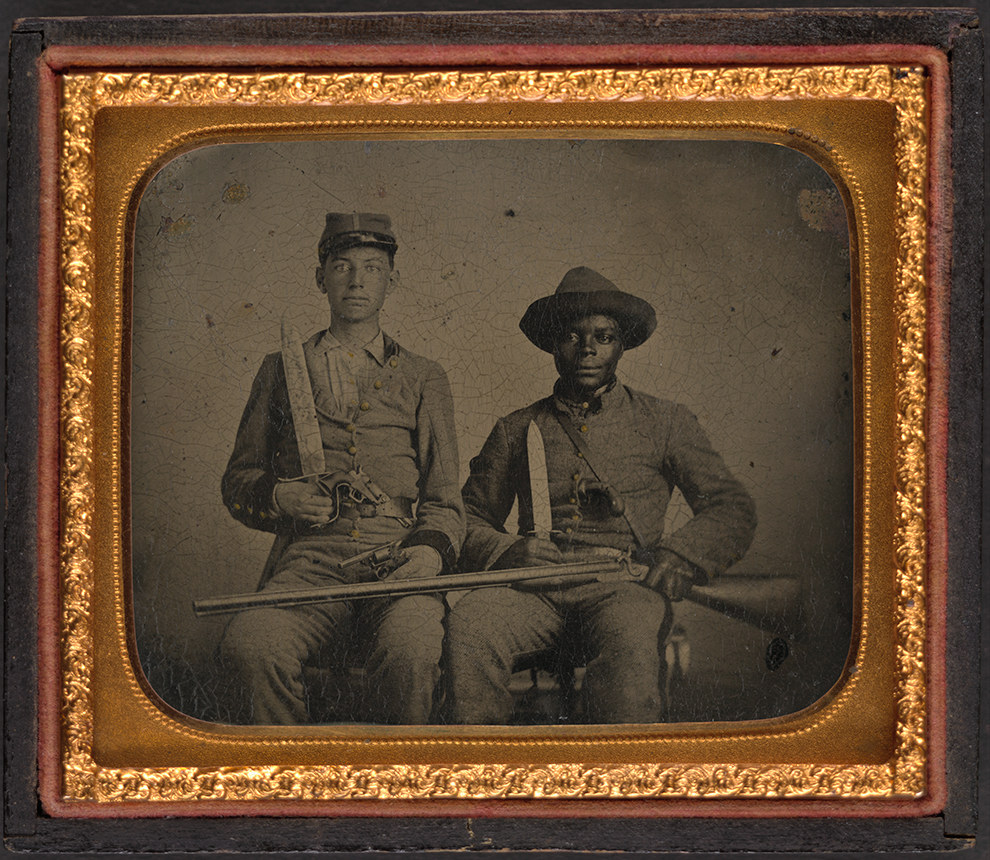The cemetery in West Point, Mississippi, is filled with leaning, weary graves, gray monuments discolored by time.
“That’s the white graveyard,” Cyril Chandler, 66, said, gesturing with a scarred hand injured in a printing press accident decades ago. “This is the black one on the other side.”
Cyril then guided me to the small stone obelisk marking the grave of his great-grandfather, Silas Chandler, a former slave who went to war alongside his Confederate master and a man who in death has become a source of controversy he could never have imagined. The Confederate flag that once flew at his resting place is gone, as is the metal cross placed there by the Sons of Confederate Veterans and the United Daughters of the Confederacy in a 1994 ceremony to honor his “service,” complete with a 21-gun salute. According to the SCV, the cross was not an award for valor or bravery, but simply denoted that Silas was a Confederate soldier.
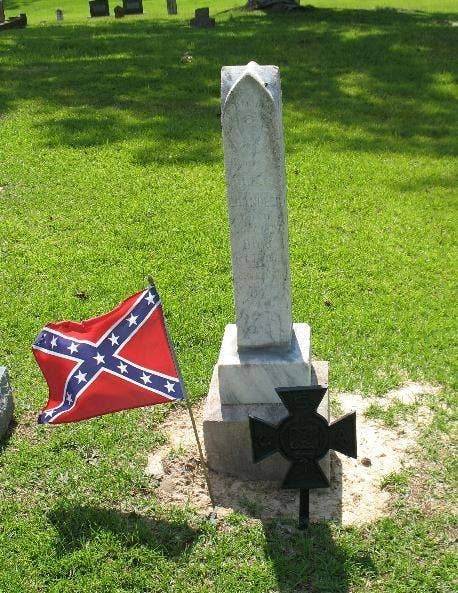
The ceremony was a reunion of sorts between the two Chandler families, white and black. Andrew Chandler Battaile Sr., a great-grandson of Silas’s master, said at the time that reconnecting with Bobbie Chandler, 83, Silas’s great-grandson, was “truly as if I had been reunited with a missing part of my family.” Although Bobbie and Cyril Chandler were both present, their other siblings refused to attend the event. They wanted no part of the ceremony, or the implication that Silas had served the Confederate cause willingly.
Myra Chandler Sampson, 76, Silas's great-granddaughter, began researching Silas’s life and concluded he was no soldier, but a slave. Sampson, along with other family members, in 2008 signed a petition letter, which was later published on the website of Kevin M. Levin, a historian who has spent countless hours rebutting tales of black Confederates — and the story of Silas Chandler in particular. The letter calls the honors laid at Silas’s grave “a great insult to Silas and all of his descendants.”
“We didn't like that Confederate flag bein' on his gravesite and we didn't like that iron cross,” said Sara Wims, 80, another of one of Silas’s granddaughters.
This much the two Chandler families can agree on: Silas Chandler was there when his master, Confederate Sgt. Andrew Chandler, was gravely wounded at the 1863 Battle of Chickamauga in Tennessee. Silas helped his injured master return home, saving Andrew’s leg from amputation.
This story might have remained, like many others, just another Civil War tale passed down from one generation to the next, if it weren’t for an astonishing tintype of the two men, armed to the teeth in Confederate uniforms, taken in 1861. The image has helped bolster the claims of the community of amateur historians, hucksters, and Confederate sympathizers committed to defending the Confederacy from the charge of racism, who insist that thousands of black men fought and died for the rebel cause. “Ever since the SCV posthumously honored Silas,” Levin wrote in 2012, “accounts of black Confederate troops have surged in popularity.”
It is a community that has grown more vocal and irate as black and white activists have successfully sought to strip Confederate emblems from places of honor around the country. After the massacre of nine black parishioners in South Carolina by a white supremacist, the South Carolina SCV defended the Confederate flag then flying on the state capitol grounds by invoking “Black Confederate soldiers” who “fought in the trenches beside their White brothers.”
In this community, the two Chandlers, master and slave, have become icons of Southern virtue, proof of the benign nature of the Confederacy and the harmonious antebellum relationship between blacks and whites. Confederate websites like Dixie Outfitters sell merchandise celebrating the “Chandler Boys” and their battle-forged friendship. Here, they say, is proof that the cause of the Confederacy was not slavery, not the eternal gospel of white supremacy, but freedom. After all, how could a racist society have inspired such loyalty from its black subjects?
The finer points about Andrew and Silas — fogged by the passage of time, the fallibility of memory, and simple family loyalties — are more difficult to parse.
More than 150 years after Robert E. Lee’s surrender at Appomattox Court House, our perception of the Civil War and its aftermath still shapes Americans' understanding of racism. The saga of the two Chandler families is no different, except that the finer points about Andrew and Silas — fogged by the passage of time, the fallibility of memory, and simple family loyalties — are more difficult to parse.
“It is not difficult to speculate that as a result of sharing these very trying life experiences that a special bond existed between [Andrew and Silas],” wrote Battaile Sr. in Black Southerners in Gray, a 1994 anthology containing essays testifying to the existence of thousands of black Confederate soldiers. He also wrote that he hoped to meet more of Silas’s descendants and “renew the bonds that existed between our ancestors.” The cover of the anthology bears the iconic image of Andrew and Silas.
But where Andrew Chandler’s descendants recall an intimate friendship that lasted for generations, and neo-Confederates see evidence of a post-racial Confederacy, Silas Chandler’s family sees a slave forced to serve a cause he did not believe in, not only in life but also in death.
“They dressed him up like a monkey,” Sampson said, “and took him off to war.”
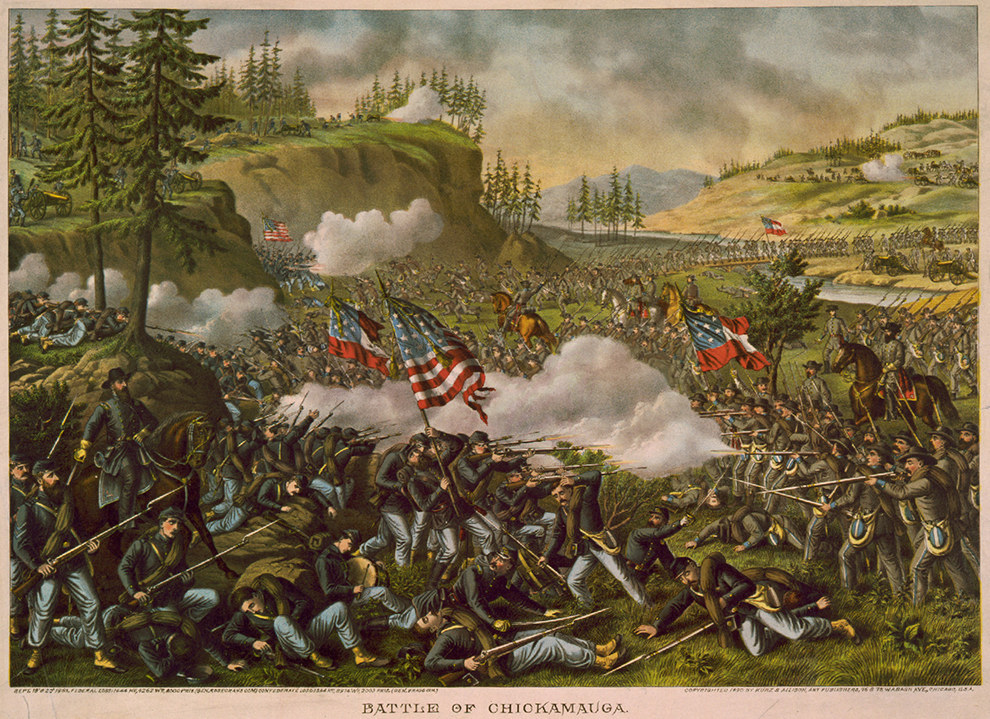
Silas Chandler’s 1916 pension application would seem to settle the issue of whether he was slave or free: the 11th line asks about the “vessel in which your owner served.” But then there’s that tintype.
Andrew sits with a face like stone, sword resting on his shoulder, a pistol in his hand and one in his belt. Silas sits slightly lower than Andrew, an inscrutable expression on his face: Amusement? Resignation? Happiness? Determination? He carries a smaller knife and the tail end of a shotgun draped across their legs. They are both in uniform, therefore they must both be soldiers, comrades, equals. How could anything else be true?
Andrew M. Chandler's family recalls the two men as not having a typical master and slave relationship. “Andrew Martin and Silas kind of grew up together and were crawling around on the kitchen floor as children,” Andrew Chandler Battaile Sr. said. “And they hunted and fished and grew up as young boys together.” According to his pension application, Silas was born in 1838, seven years before Andrew, and was one of 36 slaves owned by the Chandlers.
Mississippi seceded in January 1861, declaring, “Our position is thoroughly identified with the institution of slavery,” and decrying the Northern states’ supposed designs on “negro equality.” At the time, almost half of Mississippi’s white population owned slaves, and slaves made up a majority of the state’s population.
The iconic photo was taken some time after Andrew took Silas to war later that year. Both families recall Silas being the line of communication between battlefield and family, transporting messages and supplies back and forth. Andrew's regiment fought through some of the toughest battles of the Western Theater of the Civil War, and Andrew was captured at the Battle of Shiloh in April 1862.
According to a letter Levin provided to BuzzFeed News, Andrew wrote to his mother, Louisa, in August, worried that Silas could end up in Union hands. “If the Feds were to capture him, they might take him along with them,” Andrew wrote. Andrew’s concern about Silas’s capture could be interpreted as concern for a dear friend. But it could have just as easily been fear of losing his property. That month, President Abraham Lincoln had signed the Second Confiscation Act, freeing all slaves owned by Confederate soldiers. If the “Feds” had “captured” Silas, he’d be a free man.
In September 1863, Andrew Chandler and his regiment, the 44th Mississippi Infantry, were part of the Confederate forces under Gen. Braxton Bragg that routed Maj. General William Rosecrans’s Union forces at the Battle of Chickamauga. The battle was one of the bloodiest of the war, with 16,000 casualties on the Union side and more than 18,000 on the Confederate side. The 44th suffered greatly, with nearly 30% of the 272-soldier regiment killed or injured.
Andrew was shot in the leg during the battle. Family legend has it that the Confederate surgeon recommended amputation, and Silas, using a gold coin sewn into his jacket for emergencies, bought a crate of whiskey to bribe the surgeon to let him take Andrew away. He managed to smuggle Andrew onto a boxcar to Atlanta. Genealogy notes passed down by Andrew’s family contain the recollections of Mary Ivy Chandler, Andrew’s daughter. Mary Ivy says in the notes that Andrew’s uncle, Kyle Chandler, was waiting in Atlanta with a carriage and a nurse to bring Andrew and Silas back.
"He could have run away at any time, I'm sure."
A Confederate medical document from 1864 uncovered by PBS confirms the story of Andrew’s injury, showing a gunshot wound to his right leg and ankle at Chickamauga, but nothing beyond family lore supports the gold coin story — neither Mary Ivy’s account nor his obituary in Confederate Veteran magazine mentions it.
"I never heard that story, until Silas came to the forefront on the internet, after the story that was built up to put that iron cross on his grave,” said Myra. "I never heard that from my grandfather; I never heard that from my father. I never believed that they would have given a slave money."
In fact, the genealogy notes raise the possibility that it may have been Kyle, not Silas, who got the whiskey, and for the hometown doctor rather than the army surgeon. “Uncle Kyle paid the doctor $40 a day for his services in caring for Papa, and that was what one quart of whiskey cost him,” Mary Ivy says in the notes. “I often wonder if the whiskey was for patients or if the doctor drank it.”
Regardless, Andrew’s leg was saved, although it would never again work properly. Silas was sent back off to war as a servant for Andrew’s younger brother, Benjamin Chandler, in the 9th Mississippi Cavalry.
Battaile Sr. believes Silas served the Chandler family out of loyalty. “I don't think it was something that he seriously objected to, because he had freedom to go back and forth and travel at will,” he said. “If he had been totally against it, he could have run away at any time, I'm sure.”
Silas's family members recall that relationship, and the iconic photograph of the two men, very differently. “The Confederates always [say] that he could’ve run away any time, he always returned,” said Myra. “He always returned because he had a wife and his first son, William Henry, was born while he was off at war ... That’s why he never ran away.”
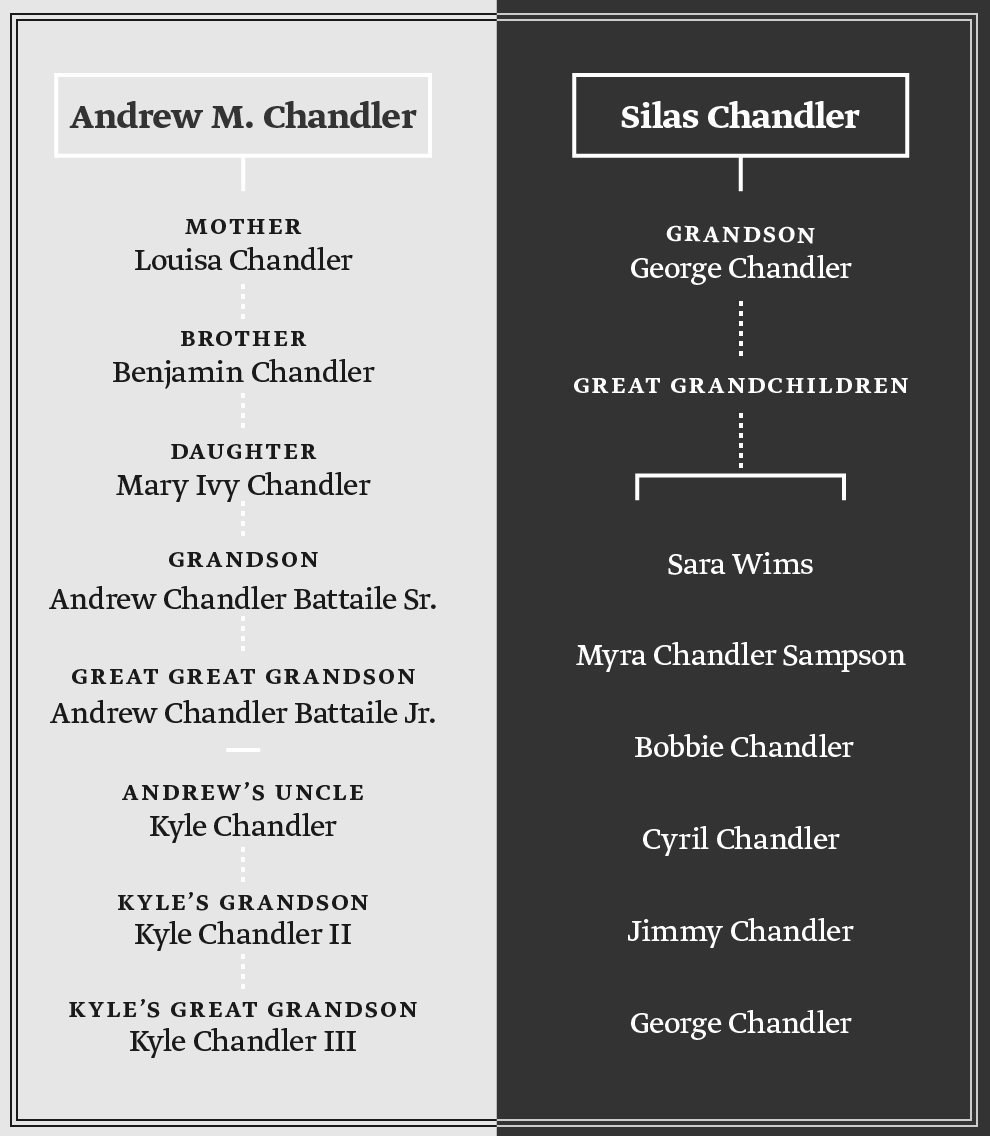

Southern partisans laid the foundation of the post-racial Confederacy shortly after its defeat. Knowing that the eyes of history would view the cause of slavery as, in the words of Ulysses Grant, “one of the worst for which a people ever fought,” the vanquished Confederates sought to deny that they had ever fought to preserve slavery, or that their society had been built on the idea that white men were superior to black men.
As recounted in Bruce Levine’s Confederate Emancipation, in 1865 former Confederate Vice President Alexander Stephens disowned his famous “Cornerstone Speech,” which declared that slavery was “the proper status of the negro in our form of civilization.” Stephens blamed the supposed misunderstanding on “reporter’s notes which were very imperfect.” Southern champion Robert E. Lee insisted in 1870 that “far from engaging in a war to perpetuate slavery,” he was “rejoiced that slavery is abolished.” Jefferson Davis, the first and only Confederate president, wrote in 1881, “The existence of African servitude was in no wise the cause of the conflict.”
Thus began the "Lost Cause" mythology, what historian David Blight has called “a propaganda assault on popular history and memory,” meant to exonerate the Confederacy of the most significant cause of its brief existence. A century of pro-Confederate historical agitprop has dismissed slavery as the central cause of the war, framing the Confederates' treason in defense of slavery as a response to Northern aggression, and the nation’s brief experiment with interracial democracy as a tyrannical failure. Even now, many Americans still believe that the Confederacy was not fighting for slavery, but rather over tariffs or “states' rights.” When the state of Mississippi declared April Confederate Heritage Month in February 2016, Gov. Phil Bryant’s proclamation, unlike Mississippi’s 1861 declaration of secession, did not even mention slavery.
The Lost Cause’s hold on popular culture is diminishing, but its legacy is maintained by Confederate heritage organizations like the Sons of Confederate Veterans and the United Daughters of the Confederacy. But one of the cornerstones of the Lost Cause myth — though one even the SCV would not embrace today — is the happiness of slaves during bondage, and the great tragedy of emancipation. “Had these Africans been a cruelly oppressed people, restlessly struggling to be freed from their bonds, would their masters have dared to leave them, as was done, and would they have remained as they did, continuing their usual duties?” Davis wrote in his memoir.
Nevertheless, the SCV maintains that black men did willingly fight for the South. “I think probably only a few people would say there were no black soldiers in the Confederate Army—there were,” said Marc Allen, public affairs officer for the Mississippi Division of the SCV. "You have to ask yourself a question: Why would they do that? Why would they fight in a war so that slavery could be maintained, so that they could continue being a slave? Well, the easy answer is, that wasn’t what the war was fought about chiefly."
There are precious few testimonies from former slaves forced into Confederate service. Within the thousands of records in the Federal Writers' Project Slave Narratives — a New Deal project that sent white and black writers into the South to gather stories of Civil War–era life — BuzzFeed News found only a handful of interviews with former slaves forced to labor for the Confederacy. But it’s difficult to know exactly what the freedmen thought, because even where they appear to speak freely, their words may be shaped by their perception of what their mostly white interviewers wanted to hear.
“Lots of old slaves closes the door before they tell the truth about their days of slavery,” said Martin Jackson, who was brought to war by his master. “When the door is open, they tell how kind their masters was and how rosy it was. You can’t blame them for this, because they had plenty of early discipline, making them cautious about saying anything uncomplimentary about their masters.”
“My memories of slave days was my easiest days,” William H. Harrison, who was brought to war by his master as a “servant in the battlefield,” told his interviewer. “Slavery was pleasant for me.” Yet Harrison also tells the interviewer he has always voted Republican, the party that “freed my race.” The hardships of freedom superseded whatever pleasantries he found in bondage.
The claim that blacks willingly fought for the Confederacy has moved from neo-Confederate fever dreams to mainstream discourse.
At least one slave, Gus Brown, identified with the Confederates to his interviewer. “We wasn’t beaten, we wuz starved out!” he said when asked about the war. “In all de years since de war I cannot forget old massa," Brown said. “He was good and kind. He never believed in slavery but his money was tied up in slaves and he didn’t want to lose all he had.” Nevertheless, Brown said, “When the time came for freedom most of us was glad. We liked the Yankees. They was good to us.”
Jackson also spoke of the ambivalence he felt toward the Union Army, whose guns were pointed in his direction. “I knew the Yanks were going to win, from the beginning,” Jackson said. “I wanted them to win and lick us Southerners, but I hoped they was going to do it without wiping out our company.”
As historians have written, hundreds of thousands of free blacks and slaves were indeed forced to labor for the rebels in menial roles, though many fled to Union lines to become soldiers and fire upon their former masters. The conviction, shared by Jefferson Davis and others, that the human chattel they forced into service did so out of love for the South’s nascent slave empire is the origin of the Black Confederate myth. But no black Confederate soldiers ever took the field in battle.
Nevertheless, the claim that blacks willingly fought for the Confederacy as soldiers has moved from neo-Confederate fever dreams to more mainstream discourse. John Stauffer, a professor of English and of African and African-American studies at Harvard, wrote last year in The Root that he believes that between “3,000 and 6,000” blacks “served as Confederate soldiers.” This is identical to Allen’s estimate.
“Because of human nature, there had to be somebody black who volunteered to serve in the Confederacy,” said The Root’s co-founder Henry Louis Gates Jr. at a panel last year, endorsing Stauffer’s claim. “There just had to be.”
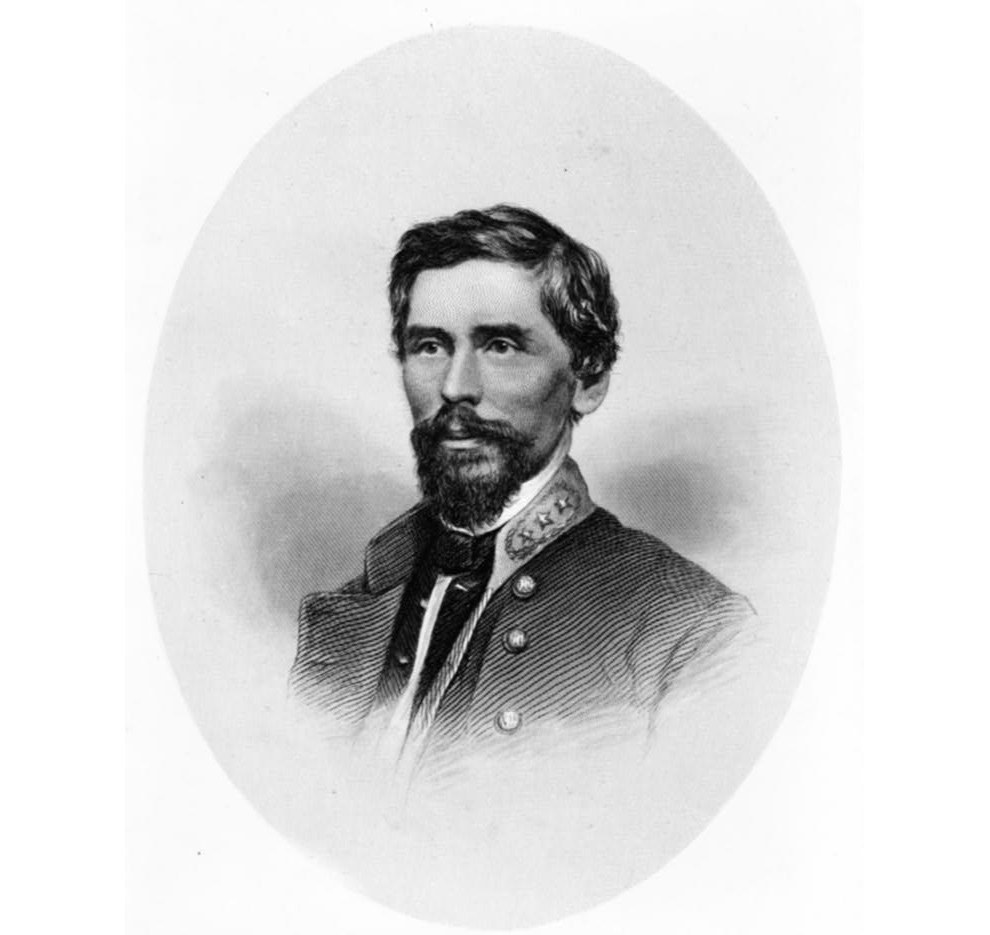
There in fact were — but volunteering to serve and actually serving are two different things, and history is unkind to conjecture. In 1863, Confederate Maj. Gen. Patrick Cleburne developed a secret plan for training and arming slaves against the Union. As Levine writes in Confederate Emancipation, the proposal was so controversial that Davis ordered it suppressed. When soldiers in Confederate units were even suspected of having mixed blood, Levine writes, they were immediately purged. In the Confederate Army, one drop of Negro blood was one too many.
The war ended before the any of the recruited slaves saw battle. The CSA was sharply divided by the notion of recruiting black soldiers. As Confederate Maj. Gen. Howell Cobb proclaimed, “If slaves seem good soldiers, then our whole theory of slavery is wrong.” Black soldiers put the lie to racial inferiority, the entire basis of Confederate society and the Confederacy's secession from the United States.
Only on the verge of annihilation, and with the intention of granting slaves emancipation in name only, did the Confederacy once again consider fielding black soldiers. Confederate leaders carefully sketched out a state of near-bondage that would offer nominal freedom to former slaves but keep them in a state of omega-class citizenship as a captive workforce. After the war, Frederick Douglass would bitterly note that, despite the Confederacy’s defeat, that state of near-bondage was precisely what awaited the freedmen and freedwomen, a condition that lasted well into the 20th century.
When Confederate imagery re-emerged in the 1950s and '60s in defiance of the civil rights movement, there was little dispute that these emblems were meant to signal devotion to the enduring principle of white supremacy. But just as the Confederacy fell before Union guns, the civil rights movement sparked an unfinished cultural shift that discredited white supremacy in its overt forms.
“You might think of the Black Confederate narrative as the modern version of the loyal slave narrative,” said Kevin M. Levin. “The first references to black Confederate soldiers really don’t appear until roughly the late 1970s, and it’s in response to a changing memory of the Civil War.”
The discipline and valor of civil rights activists forced whites to recognize the long-denied humanity of black Americans. Historians like John Hope Franklin and Eric Foner dismantled the Lost Cause propaganda of their predecessors. Shows and movies like Roots and Glory testified to the horrors of slavery and the bravery of black Union soldiers earning their freedom by blood and fire. And so lionizing the Confederacy would have to mean reinventing it wholesale.
The ease of publishing misinformation on the internet would allow the viral lie of black men willingly fighting for the South to flourish. In the quest for a new, post-racial Confederacy, groups like the SCV would seek out blacks who were forced to serve the Confederacy and celebrate their contributions as if they were voluntary, granting them Confederate honors and even holding ceremonies at their final resting places. Not even death could prevent them from being forced to serve the Confederate cause one last time.
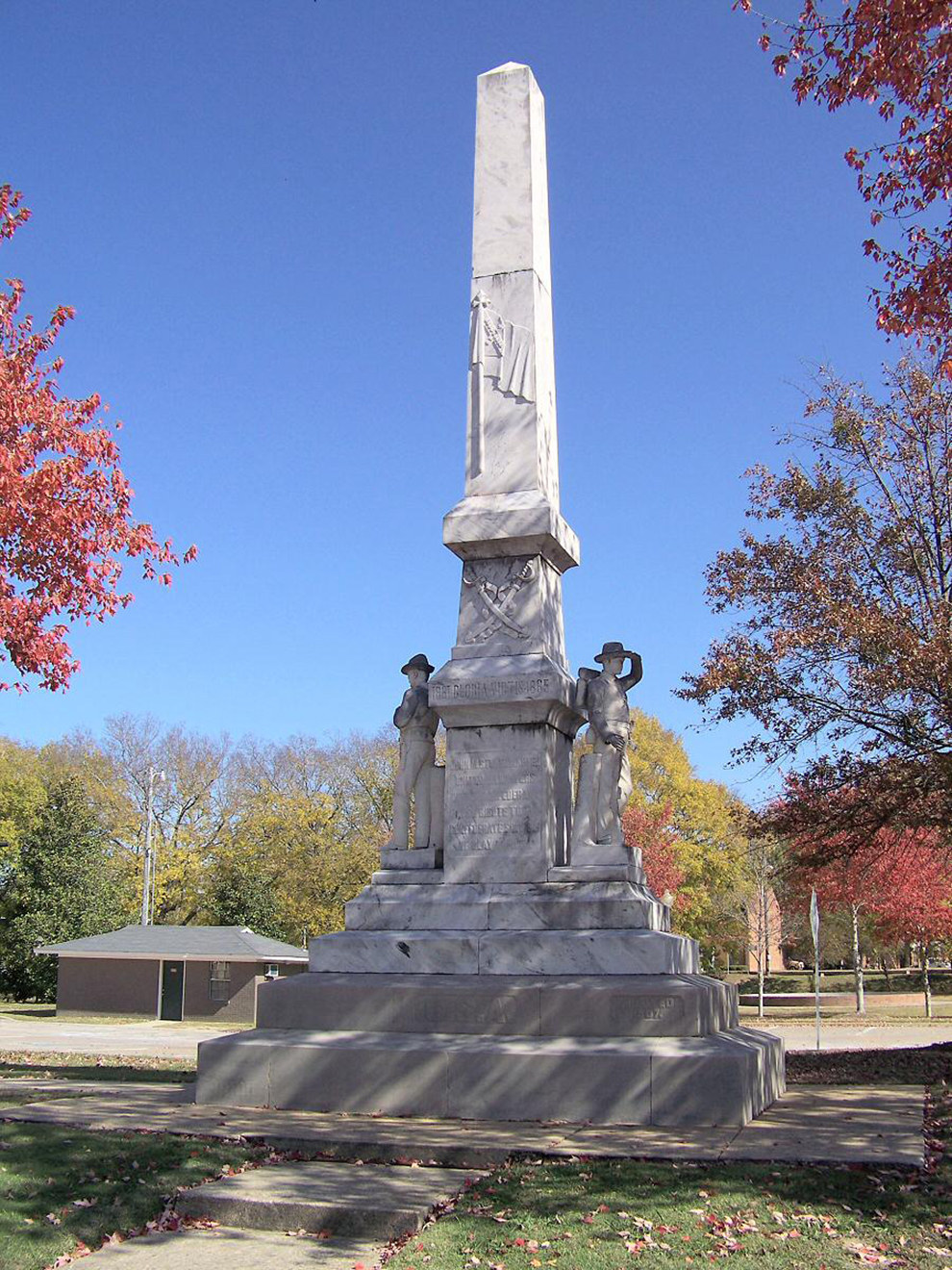
“They want people to believe that the slaves were happy, they were happy to be slaves, and they would fight so that they could continue to be slaves,” said Myra, Silas’s great-granddaughter. “I would not be here today, had he decided that he would not go off to war with his master’s son. I would not be here today talking to you.”
"I don't think anyone in this organization or any other organization would try to get other Americans to believe slaves wanted to fight so they could continue to be slaves," said Allen of the SCV. "They didn't take up arms to keep the institution of slavery — they did it because they believed it was important to do that for the sake of safety. The Union Army was not nice, it was not good. They committed genocide against the Confederate States of America."
But if there were any isolated instances of slaves taking up arms, it was as property, not as soldiers. Pension records from former Confederate states play a key role in perpetuating the fraud of blacks fighting with the rebels as soldiers — ironically so, since the details frequently disprove claims of black Confederate soldiering.
Though pensions were given to former soldiers and to slaves forced to serve, the records are frequently used as evidence that black men were actually soldiers. In 2014, South Carolina Gov. Nikki Haley dedicated a memorial to Mattie Clyburn Rice, the second black member of the UDC considered a “Real Daughter,” because her father, Wary Clyburn, was supposedly a “Confederate veteran.” His pension, however, notes that he was a slave who accompanied his master to war as a “bodyguard.”
If there are any isolated instances of slaves taking up arms, it was as property, not as soldiers.
Nelson W. Winbush, a black member of the SCV from Tennessee, told anyone who would listen that his grandfather, “private” Louis Napoleon Nelson, was a Confederate soldier fighting under Nathan Bedford Forrest, the first national leader of the Ku Klux Klan. Nelson’s pension records actually list him as a “cook” and “servant.”
An example of a black Confederate soldier that Allen provided to BuzzFeed News was Holt Collier, a Mississippi man whose biography from the U.S. Fish and Wildlife Service identifies him as having “joined the Confederacy” to become a “sharpshooter” and “military spy.” Collier’s pension records identify him as a slave.
None of these stories, however, have anything like the arresting tintype of Andrew and Silas Chandler, an image that seems to embody fantasies of the post-racial Confederacy, which explains why to this day those testifying to the existence of black Confederates invoke their image. As recently as January the Richmond Times-Dispatch published a syndicated column invoking the myth of black Confederates featuring the photograph of Silas and Andrew.
Myra Chandler said that her father, Silas’s grandson, went to his grave angry that Silas’s image had been used to perpetuate a myth. “He knew that Silas was not a soldier — he was a slave,” Myra said. “And he knew that he was being used to promote something that was false.”

Confederate heritage organizations were first alerted to the story of Andrew and Silas in the early 1990s when Bobbie Chandler, Silas’s great-grandson, gave a copy of the famous photo to the Washington Times for a story. Bobbie worked there as a production manager.
“We had employees donating different things and I donated the story of Silas,” Bobbie said. “That’s what started everything.” The Washington Times story led to the reunion between the descendants of the two men, and drew the attention of the UDC and SCV, which culminated in the 1994 ceremony at Silas’s grave.
The original tintype might have remained hidden, but for Andrew Chandler Battaile Jr.’s decision to have it appraised on a 2010 episode of Antiques Roadshow on PBS. “They're about the same age, joined the Confederate Army when Andrew was 16, Silas was 17, and they fought in four battles together,” Chandler Battaile Jr. told the appraiser, Wes Cowan, on Antiques Roadshow. Cowan estimated the value of the photograph at $30,000 to $40,000.
“It's very interesting to learn more about it, and I'm honored to be able to steward this on behalf of my family and Bobbie's family,” Andrew Battaile Jr. told Cowan, who emphasized the rarity of seeing a contemporary image from the Civil War of a black man in Confederate uniform.
“It’s the only one of its kind,” said Tom Liljenquist, a prominent Civil War photo collector whose name is featured on a collection at the Library of Congress. “How many pictures have you seen of a Confederate soldier with his slave? There aren’t any.”
The Antiques Roadshow episode spurred an episode of History Detectives, with Cowan seeking to determine the nature of the relationship between Andrew Chandler and Silas Chandler.

“According to their family story, the Chandlers granted Silas his freedom just before the war and that he fought heroically alongside his former master in the 44th Mississippi Regiment,” Cowan noted on History Detectives. (Battaile Jr. told BuzzFeed News that he first heard Silas might have been a soldier from Bobbie Chandler. Bobbie says he first heard Silas might have been a soldier from a write-up in the neo-Confederate publication Southern Partisan.) It’s unclear where this piece of family lore that Silas was freed crept in — the 1949 newspaper article about their relationship during the war describes Silas as Andrew’s slave.
Cowan proved that Silas was a slave through his pension records, that he had not been set free or bought his freedom prior to the war and that the Chandler family had not donated the land upon which Silas founded a church for former slaves after the war. The weapons in the famous photograph were props likely given to them just for the picture.
“I think it’s interesting to understand the place of stories in family histories. Obviously, the story that we’ve shared is one that is very comfortable, and comforting to believe,” Battaile Jr. told Cowan. “But without documentary evidence, it is a story. Our families’ histories have been, and will always be, deeply intertwined and evolving with the times.”
The episode seemed to show the Chandler families united, as they appeared to be the warm, rainy day that the SCV and UDC laid honors at Silas’s grave in 1994. Bobbie and Andrew Chandler Battaile Sr. were both there, representing Andrew and Silas, seemingly reconciled. Myra Chandler Sampson, in the meantime, was frustrated because the episode confirmed what she had discovered through her research: Silas was no Confederate soldier.
"They took his money and let him think he bought his freedom."
The discoveries on History Detectives upended stories that both families had told for years. Andrew Chandler’s family believed Silas had been freed and had therefore joined the Confederate cause willingly, and Silas’s family believed that Silas, a talented carpenter, had bought his freedom through money he earned by doing odd jobs on the side in West Point, Mississippi. Neither story could possibly be true — Mississippi outlawed manumission of slaves, and after emancipation there would have been no need for manumission.
Silas’s family had always believed he had bought his own freedom. The realization that he couldn’t have made Silas’s grandson believe that Silas had been “tricked” into buying a freedom that had already been purchased in blood. “My father believes that Silas was already freed when he bought his freedom,” said Myra Chandler Sampson of her father, Silas’s grandson. “And they took his money, and let him think that he bought his freedom.”

Today West Point is still a mostly black town of about 11,000, dotted with aging memorials to the Confederate States of America. Cyril Chandler moved back in the 1970s to live in the home built by Silas’s son in the same place where Silas once built his own dwelling, across the street from the church Silas founded. Silas’s name is carved into the cornerstone. Silas and his wife, Lucy, had 12 children, and he taught his sons to shoot and to build, lessons that were passed down through the generations. He taught them to rely on, and defend, themselves.
“My granddaddy, he always bragged on the fact that he could shoot a squirrel's eye out as he's climbin' up a tree,” Silas's great-granddaughter Sara Wims said with a laugh. “People around the town, a lot of times there were some whites that were not so nice — they knew that he would shoot those guns at any time.”
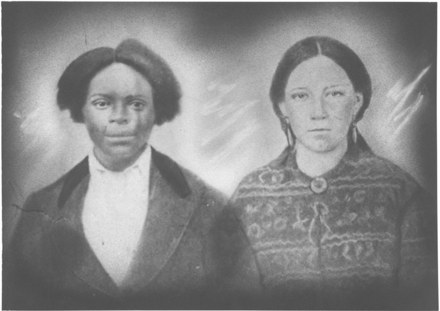
Battaile Sr. said Silas remained close to the family after the war. “My mother knew him very well,” he said. "He used to take her fishing and picnicking and things like that. He stayed close to the family after the war and after emancipation.”
Nevertheless, the families connected rarely as time went on. The Chandler Battailes moved elsewhere, while the descendants of Kyle Chandler, Andrew’s uncle, remained in West Point. Sara Wims recalled a Chandler family reunion near or in West Point in which Silas’s son, her grandfather, George Chandler, was invited. (Neither Kyle Chandler III nor Andrew Chandler Battaile Sr. recalled the family reunion.)
“I was about 15, and they invited my grandfather to come to tell them about Silas,” said Sara. "But they wanted him to bring me along, since I was 15, so that I could babysit the kids that were there. At that time, my grandfather wouldn't hear of it.” George, she said, refused to sit at a table with Andrew Chandler’s family, despite being invited to do so. “Maybe he had been so conditioned that he didn't feel as if he should be a part of the family as much as sitting with them to eat.”
The interactions between the families were not all fraught. Bobbie Chandler recalled that, when their home burned down when he was a child, the descendants of Kyle Chandler living in West Point helped out financially, donating money to build a new house. (Kyle Chandler III said he did not remember if his family had helped out Bobbie’s.)
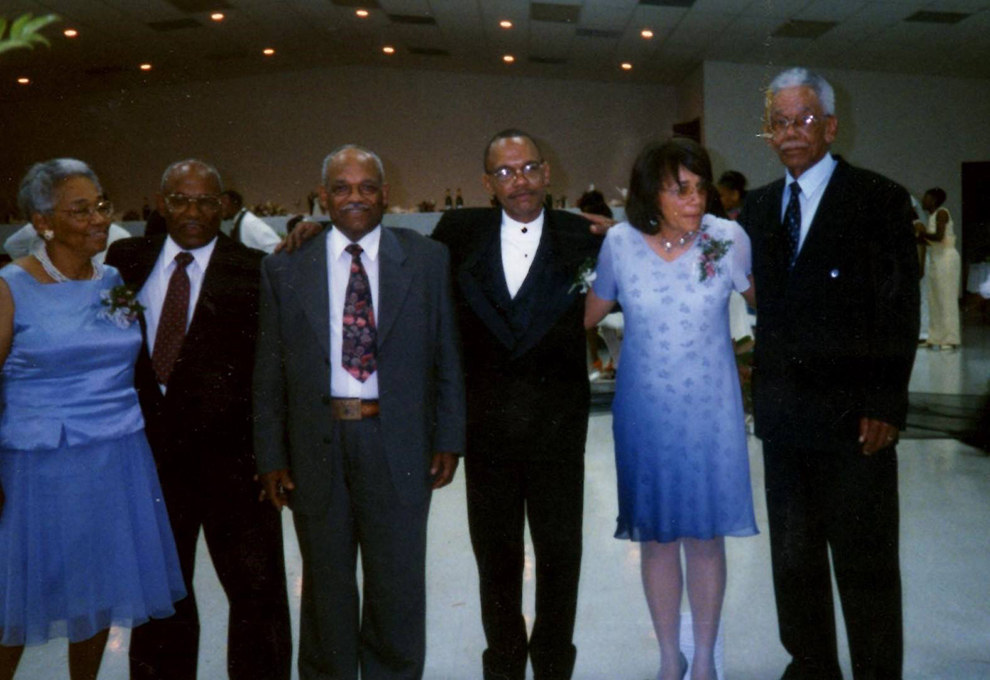
Silas Chandler’s grandchildren grew up in a segregated West Point full of paradoxes. Silas’s labors had left them better off than many of their white neighbors, who were friendly when no one was around but denigrated them when other whites were present. They went to a private all-black Presbyterian school instead of the local segregated one.
“After school we used to get out there with the white kids and play ball,” said Bobbie. “A couple times they had people come by and say, 'The white kids and the black kids are not supposed to play ball together.’”
Myra’s recollection is a bit harsher. “They were only friends with us when they were around us — for sure we played with them. I even took a bath with the little girl, she was my friend,” Myra said. “But outside of our neighborhood, we were niggers. So that’s the way that was.”
Most of the black Chandlers moved away from West Point, except for Cyril, who moved back in 1972 after college and started his own printing business. After going to Howard University, Sara moved to Detroit to raise her children. Myra was a schoolteacher in California until she retired years ago. Bobbie and his brother Jimmy ran a printing business together for 30 years in Washington, D.C. (A sixth sibling, George, moved to Chicago, where he worked in a metal refinery. He died last year.)
Though they mostly lost touch with Andrew Chandler’s family before the ceremony in 1994, state documents show at least one of his descendants, Kyle Chandler II — from the same family that Bobbie said helped out when Bobbie’s home burned down — was a member of the White Citizens’ Councils in West Point in the late 1950s, an organization dedicated to preserving white supremacy. Kyle is named as a member of the council in a document that identifies George Chandler, Silas’s son, as one of the members of the black community who might be “members of the NAACP and potential troublemakers in the event of a racial crisis.” (Battaile Sr. described Kyle as a “distant cousin,” Kyle Chandler III seemed surprised and dismayed by the information about his father, Kyle Chandler II.)
Bobbie said that he has a “good relationship” with the Chandler Battailes, and that they used to go out to dinner together when he visited Mississippi, but haven’t spoken in years. Once it became clear that Silas was a slave, not a soldier, Bobbie and Cyril decided they agreed with the rest of the family and didn’t want the Confederate honors at Silas’s grave.
“I’m glad that the Confederate flag was moved off of his grave, and I’m glad that the Confederate flag has been removed from the state capitol and things like that, in some states,” said Bobbie. “I made a mistake.” The cross was stolen, and though Confederate flags continued to be placed at Silas’s resting place, those would disappear too. Sometimes Cyril would take them, sometimes someone else.
As for the tintype, Bobbie told BuzzFeed News that Andrew Chandler’s family had agreed to split the money with them if it was sold. "I never did receive any of that,” he said.
Andrew Chandler Battaile Jr. — who today works for the foundation that preserves Stratford Hall, the ancestral home of the family of Robert E. Lee — says there was no such agreement, despite the fact that the value of the photograph is due to Silas’s presence in it. “I never heard of such an agreement, no,” Battaile Jr. said.
The tintype was sold to Liljenquist, the collector, for an undisclosed amount, in 2014. Liljenquist, who promptly donated the photo to the Library of Congress, told BuzzFeed News that the sale contract prohibited him from disclosing the price he paid.
Silas’s descendants are relieved that the picture ended up in the Library of Congress. But for some of them, the sale of the photograph means that the family that once owned Silas was able to exploit him one final time.
“It’s just continuing to make money off of a dead slave, that’s the way I see it, them selling the tintype,” said Myra. “So that’s pretty low. That’s about as low as you can go.“
